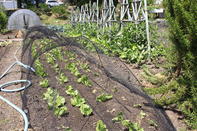Crop Rotation
Plant lettuce after Brassicas and follow with Squashes or vice versa.
Yield - Tonnes per Hectare for One Plant Cycle
Iceberg lettuce
Conservative: 15
Average: 25
Good: 40+
Butter lettuce
Conservative: 8
Average: 20
Good: 35+
Romaine lettuce
Conservative: 15
Average: 25
Good: 40+
Loose leaf lettuce
Conservative: 15
Average: 22
Good: 30
Production differs greatly between areas and growers. Greenhouse production can produce two to three times the production of an open field because of the more precision farming practices, shorter growth cycles and the protected environment.
Harvesting
Always harvest in cool weather and it is best to harvest in the cool period of the morning. Harvesting is done mostly by hand as the plants are very sensitive.
When harvesting the entire lettuce head, the lettuce stalk is cut just above the ground with a sharp knife or shears. In the case of loose leaf lettuces, the outer leaves are constantly harvested over months when they reach the desired lengths.
Some big growers do harvest with mechanical harvesters and this is normally the Iceberg and Crisp head varieties that are used in the fast food, pre-packing and catering industries. Immediately after harvest place the lettuce into a cooling facility with high humidity.
Storage
Lettuce has been successfully stored for up to two weeks after picking by keeping it at between 1°C and 3°C at a 90%+ relative humidity.
Where lettuce has had to be shipped to distant markets, controlled atmosphere containers and rooms on vessels have successfully stored and supplied lettuce a month after picking.
Get the best and most up to date information from a post-harvest specialist if long storage is required. A small mistake will have devastating consequences on the product.